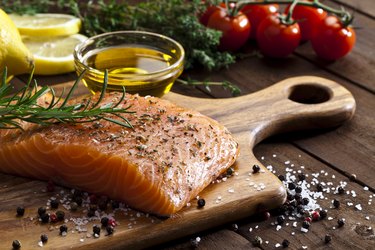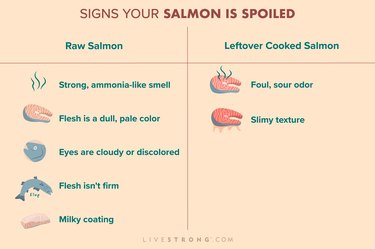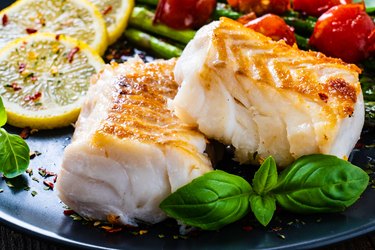
You know when salmon has gone bad if it smells sour, rancid, fishy or like ammonia. If it stinks like this when it's raw, it's likely to get stronger when it's cooked.
You don't want to risk salmon food poisoning, and experts say you should throw the fish out.
Video of the Day
Video of the Day
Tip
When you buy fresh salmon, make sure to use it within 1 to 2 days, or else store it in the freezer. Salmon that has gone bad will have a fishy odor or may even smell like ammonia, so throw it out.
Signs Your Raw Salmon Has Gone Bad
1. It Has a Strong Ammonia-Like Smell
When you remove your salmon from the package, after either refrigerating or freezing it, it should have only a mild smell and should not smell sour, pungent or like ammonia, according to the U.S. Food and Drug Administration (FDA).
Though it seems ironic, salmon is a mild fish and not one with a distinct fishy smell. These scents are indications your salmon has gone bad.
2. Its Flesh Is Discolored
Possibly the most obvious sign that salmon has gone bad is discoloration. The flesh should be free from any discoloration or darkening. Fresh salmon has a bright pink or slightly orange color. Paleness is a sign of salmon that's gone bad.
Clear, distinct white lines are also a sign of freshness. These lines are called albumin (they're coagulated proteins) and are safe to eat.
"If it has a dull, grayish appearance without defined white lines, it has likely gone bad," says registered dietitian Rachel Dyckman, RDN, CDN.
3. Its Eyes Are Cloudy or Discolored
Pay close attention to your salmon's eyes: When fish is still fresh, its eyes will be bright, clear and shiny rather than dark and cloudy, according to the FDA. The pupils should be dark and visible, and the eyes should be bulging. Salmon that's gone bad has eyes that appear sunken in.
This only applies to salmon purchased with the head still intact.
4. Its Flesh Is Not Firm
Flimsy flesh is a dead giveaway that salmon has gone bad. It should spring back when pressed gently with your finger, per the FDA. You should be able to handle salmon without it breaking up. If you notice any type of weakness in the consistency, there's a chance it's gone bad.
Keep an eye out for freezer burn, ice crystals or post-thaw mushiness. Even if your freezer is set at the right temperature (0 degrees Fahrenheit, per the USDA) but you haven't properly sealed your fish before freezing it, water molecules will try to escape, causing your salmon to become freezer-burned, per the Library of Congress. Air can then get into your salmon.
While freezer-burned salmon is safe to eat, it probably won't taste very good.
5. It Has a Milky Coating
When salmon has gone bad, a translucent film can form on the outside. This gives it a milky appearance and is a sign the salmon has gone bad.
Signs Your Leftover Cooked Salmon Has Gone Bad
1. Strong, Sour Smell
Smelling your leftovers to check if they're still fresh is always a good idea. While some foods have a naturally strong odor, salmon doesn't.
Cooked salmon that's been stored in the refrigerator may be safely eaten for up to 3 or 4 days, according to the USDA. If you notice a foul, sour odor during or after this time, it's likely gone bad and should be thrown out. Cooked salmon that is spoiled may have a rancid, sour, fishy or ammonia-like smell and shouldn't be eaten, per the FDA.
2. Slimy Texture
When you fork into cooked salmon, it has a naturally flaky texture. After a while, leftover salmon loses this flakiness and develops a slimy consistency. This usually means it's gone bad and is no longer safe to eat.
"If the salmon feels sticky or slimy, toss it," says registered dietitian and seafood expert Rima Kleiner, RD.
How to Store Salmon
In the Fridge
Never leave salmon or other perishable food out of the refrigerator for more than 2 hours, per Consumer Reports. Illness-causing bacteria can grow quickly in raw, unrefrigerated seafood, according to the FDA.
Put your salmon in the fridge as soon as you can. If you have a long drive home from the grocery store, bring a cooler with ice packs to keep your salmon cold.
Salmon in the fridge should be stored below 40 degrees F, so make sure your refrigerator is cold enough, per the FDA. Plan to eat your salmon within 2 days of buying it as long as it's fresh. Freeze any raw seafood you won't use within 1 to 2 days, per Consumer Reports.
Tip
Store salmon in the main part of the fridge. You shouldn't store any perishables on the door because the temperature on this outer part of your fridge is more likely to fluctuate, per Consumer Reports.
In the Freezer
You can refrigerate your salmon in its original store packaging, but if you freeze it, wrap it tightly in plastic, foil or moisture-proof paper before storing it in the freezer, per the FDA.
Don't freeze fatty fish like salmon for more than 2 or 3 months, according to Consumer Reports. Salmon (like any other frozen food) will last indefinitely in the freezer, but the quality will begin to deteriorate after that time, per the FDA.
If you decide to freeze your salmon, it's best to do so as soon as possible and not wait until the fish is near the end of its refrigerated life. If your salmon has been handled properly, you can refreeze it — but, moisture loss during the thawing process may mean reduced quality, according to the USDA.
Thaw frozen salmon gradually in the refrigerator — do not place it on your kitchen counter. If you must thaw your fish in a hurry, make sure it's sealed in a plastic bag and place it in a bowl of cold water, per the FDA. Check the water often to see if the fish has thawed, and then remove it from the water and cook immediately.
Your other option is to thaw it in the microwave on the defrost setting, stopping it when the fish is icy but pliable.
Salmon Shelf Life Chart
Salmon Type | Room Temperature | Refrigerated | Frozen |
|---|---|---|---|
Raw | No more than 2 hrs. | 1 to 2 days | 2 to 3 months |
Cooked | No more than 2 hrs. | 3 to 4 days | 3 months |
Smoked | No more than 2 hrs. | 3 to 8 weeks | 3 months |
Canned | 5 years (unopened) | 4 days | - |
How to Properly Thaw Salmon
There are three ways to safely thaw frozen salmon, according to the FDA: Submerge it in cold water, place it in the refrigerator or microwave it.
In Cold Water
If you need to thaw frozen salmon quickly, submerging it in colder water is likely the safest of the fastest methods. Place the salmon in a sealed, leak-proof plastic bag, and the place bag in a large bowl. Fill the bowl with cold water, and let the salmon thaw. Plan on changing the water every 30 minutes.
Small packages may thaw in an hour or less, per the USDA.
Overnight in the Refrigerator
Thawing frozen food gradually is usually the safest option. Quick methods of thawing frozen fish increase the temperature suddenly, bringing it to the "danger zone" where bacteria can grow, according to the USDA.
To thaw frozen salmon gradually, place it in the refrigerator overnight or for several hours.
In the Microwave
The fastest method to thaw frozen salmon is using the microwave. Microwave frozen salmon on the "defrost" setting and stop the cycle when the fish is somewhat icy but flexible, per the FDA.
Cooking and Reheating Salmon
Cook salmon to an internal temperature of at least 145 degrees F (you can use a food thermometer to test the temperature), per the FDA.
By cooking it to 145 degrees F, you're reducing the chances of any food poisoning or other foodborne illness, per Consumer Reports.
And remember to keep cooked seafood hot until you're ready to serve it. If you decide to chill your salmon, put the cooked salmon in the refrigerator until you're ready to serve it.
If you cook salmon as part of your meal prep or intend on having leftovers, you may wonder how to reheat cooked fish like salmon. To reheat cooked fish later, cover it with foil and place it in the oven at 275 degrees F for about 15 minutes. You can also use a food steamer to reheat cooked salmon without losing too much moisture.
Tip
Follow the 2-hour rule after cooking salmon: Never leave it out for more than 2 hours, or 1 hour if temperatures are above 90 F. It's best to serve and eat salmon immediately after it's cooked or chilled.

- Food and Drug Administration: "Selecting and Serving Fresh and Frozen Seafood Safely"
- Consumer Reports: "Keep Your Seafood Safe"
- Academy of Nutrition and Dietetics: "Keeping Your Seafood Safe"
- Library of Congress Everyday Mysteries: "What Is Freezer Burn?
- Food and Drug Administration: "Refrigerator and Freezer Storage Chart"
- USDA: "Is It Safe to Refreeze Food that Has Been Thawed?"
- USDA: "How Long Can You Store Fish?"
- USDA: "The Big Thaw — Safe Defrosting Methods"
- USDA: "How long can you keep cooked fish in the refrigerator?"


